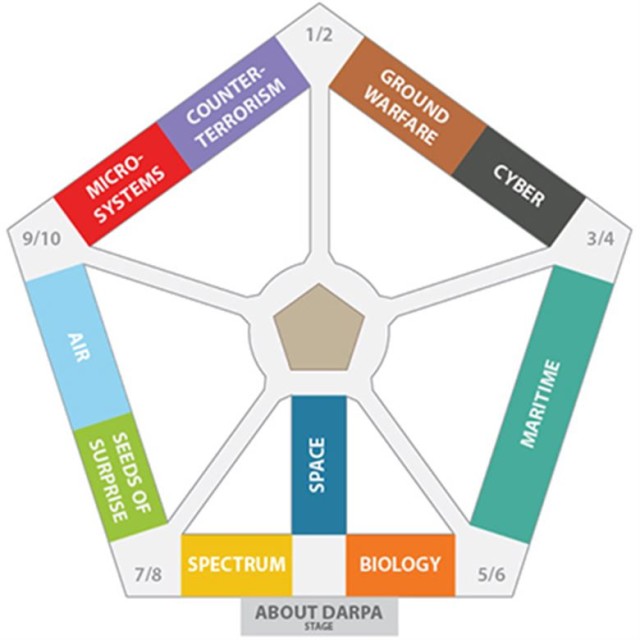The Defense Advanced Research Projects Agency yesterday hosted DARPA Demo Day 2016 at the Pentagon, giving the Defense Department community an up-close look at the agency’s portfolio of innovative technologies and military systems.
DARPA program managers and academic and private-sector project leaders demonstrated ongoing work on more than 60 DARPA programs. The event filled the Pentagon’s center courtyard with demonstrations and examples of DARPA’s game-changing technologies.
Pivotal Role in DoD’s Science, Technology Community
For nearly six decades, DARPA has played a pivotal role in DoD’s science and technology community and in the larger U.S. technology ecosystem, to pursue challenging but potentially paradigm-shifting technologies in support of national security.
DARPA Demo Day highlights agency programs at various stages of maturity, including:
— Some whose products are already being adopted by the military services and are making a difference for warfighters;
— Some that are advancing through the technological frontier that separates the seemingly impossible from the doable; and
— Some that are in the earliest phases of development, but whose potential to radically change the technological and security landscape is so great that they’re already influencing the department’s strategic thinking.
“DARPA Demo Day is our chance to demonstrate the collective energy that not only propels DARPA but also invigorates people across the wide community with which we work — defense companies large and small, commercial startups and major firms, universities, government agencies and labs, and our close partners across DoD,” DARPA Director Arati Prabhakar said in a statement.
Prabhakar added, “It is a team that revels in the opportunity to attack pressing, nearly intractable problems — all in the context of public service.”
Just as past investments in DARPA helped to secure the nation by repeatedly bending the arc of technological history, Prabhakar said, so today’s investments will give rise to capabilities that will protect the United States and project its interests for decades to come.
Range of Technologies and Scientific Domains
DARPA’s commitment to bolstering national security encompasses an extraordinary range of technologies and scientific domains.
These include dimensional scales from the atomic to the celestial, time scales from attoseconds to decades, spectral scales from radio waves to infrared to gamma rays, and, in its most recently created technical office, biological scales from genes and proteins to neurons and organs to infectious diseases and global health.
DARPA Demo Day highlights strategic investments in 10 categories spanning all of the agency’s research focus areas:
— Air: Maintaining air superiority in contested environments through unmanned aerial systems, advanced hypersonics, improved human-machine collaboration, and supervised autonomy.
— Biology: Developing breakthrough technologies to outpace infectious diseases, accelerate progress in synthetic biology, and explore new neurotechnologies.
— Counterterrorism: Mitigating terrorists’ capabilities through inventive reconnaissance, big-data analysis, and technologies that advance understanding of social behavior.
— Cyber: Protecting the data behind critical decisions through automated cyber-defense systems, hack-resistant software and networks, and real-time visualization of cyberspace.
— Ground Warfare: Exerting control on the ground through manned and unmanned systems that bolster squad-level capabilities such as reach, situational awareness and maneuverability.
— Maritime: Enhancing maritime agility in all conditions through unmanned surface and undersea systems, novel communications and positioning technologies, and distributed capabilities.
— Microsystems: Advancing communications, imaging, information processing and physical security through revolutionary microelectronic, microelectromechanical and photonic devices.
— Seeds of Surprise: Expanding the technological frontier by applying deep mathematics, inventing new chemistries, processes and materials, and harnessing quantum physics.
— Space: Asserting robust capabilities in space through robotics, new launch systems, and satellite architectures, and groundbreaking technologies for space situational awareness
— Spectrum: Assuring dominance of the electromagnetic spectrum in congested and contested environments through new materials and tools, faster chips, and smarter, more agile mobile networks
Source: DoD Press Release

